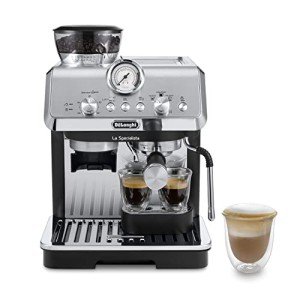10 Things Everyone Hates About Commercial Espresso Machines
The Rise of Home Espresso Machines : A Comprehensive Guide
As coffee fans continue to look for fresh and flavorful brews in your home, the appeal of home espresso machines has actually risen recently. No longer simply the domain of cafes and coffeehouse, these machines empower people to craft barista-quality espresso drinks from the convenience of their kitchens. This post will check out the numerous types of home espresso machines, their features, and factors to consider for choosing the right one. In addition, it will offer a choice of FAQs to assist potential buyers make notified decisions.
Types of Home Espresso Machines
Home espresso machines can be categorized into several classifications based upon their mechanisms and user-friendliness. Each type has its special functions, pros, and cons.
Type
Description
Pros
Cons
Manual Espresso Machines
Needs the user to manually manage the brewing procedure, including strategies like pulling a lever to produce pressure.
- Complete control over brewing procedure
- Compact design
- Requires skill and practice
- Time-consuming
Semi-Automatic Machines
Machine automates water circulation and pressure, but the user still controls the dosing and period of the developing procedure.
- Balance of automation and control
- Versatile
- Learning curve for perfecting techniques
Completely Automatic Machines
Automates the whole developing process, from grinding to brewing, often with programmable settings for customized drinks.
- Extremely user-friendly
- Quick and hassle-free
- Less control over the developing process
- Higher rate point
Capsule or Pod Machines
Utilizes pre-packaged espresso pills or pods to develop coffee quickly and easily.
- Extremely simple to use
- Minimal cleanup
- Limited flavor variety
- More costly per cup than ground coffee
Super-Automatic Machines
Integrates features of fully automatic machines with built-in grinders, enabling users to brew whole bean espresso and milk-based beverages with one touch.
- All-in-one benefit
- Ideal for milk-based drinks
- Often the most expensive
- Can be large
Functions to Consider
When choosing a home espresso machine, potential purchasers must think about the following features to guarantee they select a machine that satisfies their needs:
Grinder Type:
- Built-in mills can offer fresher grounds but might require more upkeep.
- Different mills enable more personalization of grind size.
Pressure:
- Look for machines that produce a minimum of nine bars of pressure, which is optimal for developing espresso.
Water Temperature Control:
- Machines with adjustable temperature level settings permit better extraction of flavor from beans.
Milk Frothing Options:
- Consider whether you desire a manual steam wand for frothing or an automatic milk frother for convenience.
Alleviate of Cleaning:
- Machines with removable parts and self-cleaning functions considerably lower cleanup time.
Size and Design:
- Ensure the machine fits comfortably in your kitchen and lines up with your aesthetic choices.
Budget:
- Set a budget before starting your search, as costs can vary substantially from affordable models to high-end machines.
Advantages of Home Espresso Machines
Owning a home espresso machine provides many benefits:
- Cost-Effective: Over time, developing espresso in your home can conserve coffee enthusiasts money compared to frequent café gos to.
- Customization: Users can experiment with various beans, grind sizes, and developing techniques to discover their perfect cup.
- Convenience: The capability to brew espresso any time gets rid of the need to head out to a coffee shop, especially useful throughout late nights or mornings.
- Quality assurance: With a home machine, people have complete control over the quality of ingredients and developing processes.
Downsides of Home Espresso Machines
Nevertheless, there are some disadvantages to consider:
- Initial Investment: High-quality espresso machines can be pricey, requiring a significant upfront investment.
- Learning Curve: Mastering the art of espresso developing can take some time and practice, which might be intimidating for beginners.
- Maintenance: Like any device, espresso machines need routine cleaning and maintenance to ensure optimum performance.
FAQs
1. What is the best type of home espresso machine for novices?
Response: For beginners, a semi-automatic machine is frequently advised as it offers a balance between control and automation, permitting you to discover the fundamentals without overwhelming complexity.
2. Just how much should I invest in a home espresso machine?
Response: Entry-level machines can begin around ₤ 100 to ₤ 300, while higher-end designs can range from ₤ 500 to over ₤ 2000. It's important to set a budget based on your anticipated usage and preferred features.
3. Do I need a separate grinder?
Answer: While some espresso machines include built-in mills, investing in a different grinder permits higher modification and makes sure better quality grounds.
4. How typically should I clean my espresso machine?
Answer: Cleaning frequency can differ by machine type, but it's typically suggested to clean the machine after each use and carry out deep cleanings weekly or monthly, depending upon usage.
5. Can I make milk-based drinks with any espresso machine?
Answer: Not all machines include milk frothing abilities. If you enjoy beverages like lattes or coffees, try to find a machine with a steam wand or automatic frother.
Home espresso machines are changing the method coffee aficionados enjoy their precious brews. With various types and advanced functions available in the market, there is something for everyone. Whether it's the joy of developing unique dishes or just enjoying the best shot of espresso, investing in a home espresso machine can boost both the coffee-drinking experience and the quality of life for coffee lovers all over. Similar to any investment, it is crucial to weigh the benefits versus the potential disadvantages and choose a machine that seamlessly fits both your way of life and choices.
